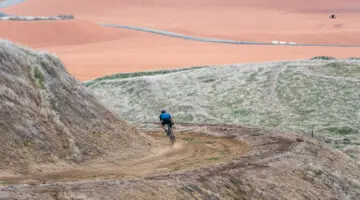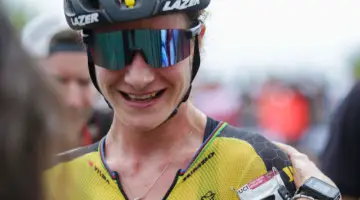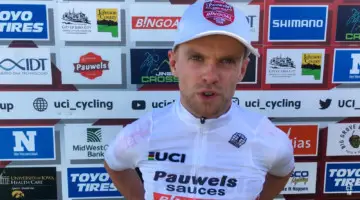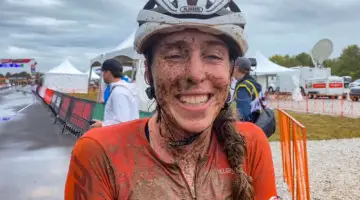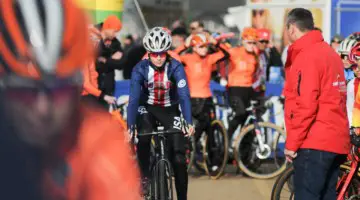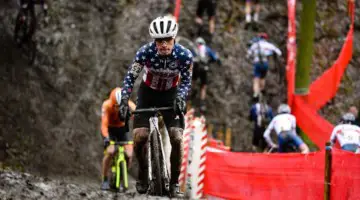Last time we talked with Ryan Trebon, the 2017 US Cup-CX had just ended at the Derby City Cup in Louisville and Kaitie Keough and Stephen Hyde were celebrating their nice paydays after winning the seven-race series overall titles. Sho-Air Cycling Group provided much of the support for the 2017 US Cup-CX, but things have changed on the U.S. cyclocross series landscape since November.
The weekend of U.S. Cyclocross Nationals in Reno, Trebon used Twitter to announce he is taking over sole ownership of the series, and since January, he has been looking for sponsors for the 2018 US Cup-CX series.
Seems like a good weekend to announce that I have taken over running the #Uscupcx from @ShoAirCG entirely and will be working and building towards a long term relationship with companies invested in the future and stability of a USA National cx series
— Ryan Trebon (@ryantrebon) January 13, 2018
We reached out to Trebon to ask him more about the future of the series and his role in directing it. During our interview, he said if he is able to secure funding, it will include five race weekends this year and add a two or three-week sub-series for amateur Masters racers.
Despite the success of the 2017 US Cup-CX series, according to Trebon, the operative word right now is “if.” He said he has faced challenges finding partners—both inside and outside the bike industry—who are willing and able to fund series operations. “The last two and half months I’ve just been kind of searching around trying to find something,” Trebon said. “I’ve had some good conversations, but no entirely concrete commitments from people. I’ve just been kind of forging ahead.”
Most companies set their budgets well before January, so he has been playing catch-up trying to find willing and able partners. “It’s January and most people’s budgets were written in August and September,” he said. “That’s the position I’ve been put in, where they don’t have the extra whatever we need.”
Right now, Trebon said he is working the phones to still try and make the US Cup-CX series happen this year. “Some people have sent me a couple of messages with potential leads, and I have couple phone calls to make today, but after 20 years of racing, it’s different to hear no and people not being interested,” he said about his full-time, and sometimes frustrating, effort.
Despite all the challenges, he is still hopeful something will work out. “I’m optimistic but I’m also realistic. I know how sponsorship searching goes,” said Trebon.
You can read the full transcript of our conversation below. Trebon covers the current state of the US Cup-CX series, his plans for 2018, the current state of athletes’ interactions with fans and a bit about what he is up to personally.
“I’m optimistic but I’m also realistic. I know how sponsorship searching goes.” – Ryan Trebon
Interview With Ryan Trebon About the US Cup-CX
Cyclocross Magazine: What’s happened with the US Cup-CX series since Louisville and where are you at now?
Ryan Trebon: At the end of the series things were going really well, and I thought we were on track for another year. Sho-Air committed to sponsoring part of the series, not really doing what they kind of did last year. It’s kind of frustrating because the end of the season puts you in a bit of a bind in terms of sponsorship searching. The last two and half months I’ve just been kind of searching around trying to find something. I’ve had some good conversations, but no entirely concrete commitments from people. I’ve just been kind of forging ahead.
All the races I want to work with are on board after how well things went last year. I haven’t heard any negatives from anyone. All races like it, all the racers like it. It’s just getting everyone to buy into it. I don’t know if it’s because I’m not good at selling it or if there are no available funds out there that people can put toward it. I’ve been looking at a lot of non-endemic sponsorship because I want to create some stability with the series, but I’ve been striking out a bit.
Unfortunately, a week ago, Sho-Air told me they don’t have the funds to keep doing what they committed to for 2018. They told me that, and now it’s like, shoot, it’s like death by a thousand cuts.
It’s a little frustrating, and I’m just trying to see if anyone has any possible leads we can work with. I’d love to keep doing it, but I’m not making any money and it’s kind of hard to live on nothing forever.
CXM: Why did you decide you wanted to keep going with the series?
RT: I feel like I have a sense of responsibility to the people involved. From the racers and the teams and stuff. If I can create something that will help them, I want to do that. These are friends of mine, but it’s also needed. Obviously last year the racing was fantastic. The interest was there. I think in the U.S. we need a series to gravitate towards. There are a lot of really good races, but if people aren’t racing together consistently, the racing gets fractured and it isn’t as competitive or interesting.
The USGP was a great thing for cyclocross in the U.S. Once it went away, everyone kind of did their own thing. I think last year showed the racing is super-competitive and we can have a really successful and robust series. It just takes people buying into it.
CXM: Along those lines, talking to Fernando Riveros Paez, his team had him kind of target the series even though he doesn’t really race cyclocross. Have you been hearing similar things from teams and sponsors?
RT: Absolutely. Leading into it, I talked to manufacturers and tried to get them on board to work with us to sponsor the series, but you know it’s January and most people’s budgets were written in August and September. That’s the position I’ve been put in, where they don’t have an extra whatever we need. They’ve said, “We can’t do anything because we don’t have the funds, but we’re planning on planning on sending trucks and participating in all the rounds.” Which for me is a sign it’s a success. People are saying, “We’re planning on coming to the races, so we can be part of it.” That’s important because we want to get all the top racers and all the top programs at each round. Everyone I talked to who was involved with it was stoked about it because it gave them something to follow. A tangible series to be a part of.
Some people have sent me a couple messages with potential leads, and I have couple phone calls to make today, but after 20 years of racing, it’s different to hear no and people not being interested. It’s not the rejection or whatever, but at a certain point, you have to be like, dang, maybe it’s just not the right product for what people want. If I’m talking the time or space of someone else who can fill the void, I’d rather let them step in. I don’t want to be in the way of cyclocross being a success in the U.S. I’d much rather it be successful with me, but at the end of the day, if someone else has a better product they want to sell and get people on board, I’m all for it. It’s just a job. You can always find another job doing something else.
I’m optimistic but I’m also realistic. I know how sponsorship searching goes.
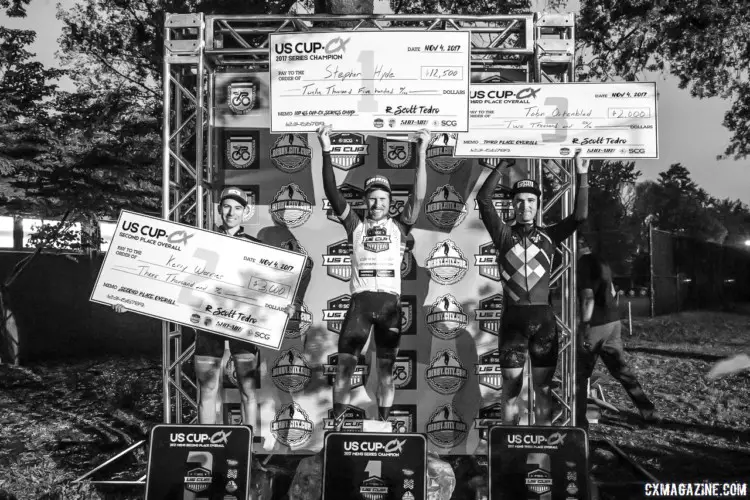
After taking over the US Cup-CX in January, Ryan Trebon has met challenges finding sponsors for 2018. 2017 Derby City Cup. © D. Perker / Cyclocross Magazine
CXM: Are there any sponsors you’ve had success with? And are there parts that are in place?
RT: The thing is I’m not a person who’s going to go out there and get commitments from 10 smaller sponsors only to have to back out. I want to have a majority of the funding in place because the smaller stuff is easier to find. It’s the large operational costs that I want to secure. I don’t want to go to people who I know and have relationships with and commit to doing something only to come back two months later and say, “Oh, we can’t do this.” I don’t feel right doing that. For me, I need to have X amount before I can say “We’re committing to doing this,” and then filling in the little gaps here and there.
I have people who I know are interested and are willing to come on board, but I don’t want to tell them we’re doing it until we’re doing it. I value the partnerships and the relationships I’ve built over the years, and I don’t want to burn those people. I’m really conservative in what I ask of them.
CXM: You mentioned on Twitter about being transparent, and I think that’s something people have appreciated about your approach, how much money are you looking for to put on the US Cup?
RT: It’s a lot less than you would think. We’re talking between $100,000 and $130,000 for everything.
CXM: That’s probably about what I would have guessed, and you certainly deserve to pay yourself for the work you’re doing.
RT: About 70 percent of that is going to costs. Things cost money. Material and infrastructure and everything are not cheap. Still, I think the value of the return is pretty good for that amount.
CXM: You mentioned this a bit, but what kind of reasons are you hearing for why companies can’t sponsor the series? Is it something the sport is lacking?
RT: I don’t think it’s something the sport’s lacking. At the end of the day, I’m not the best salesman in the world, so maybe I don’t explain it as clearly and in as an excitable way as it should be. I’d prefer to implement a process than sell someone on why they should send me money. I’m kind of burned out on always asking for cash from people. My entire career I’ve been asking people for things.
I don’t think it’s anything the sport’s missing. The sport is fantastic, the racing is really good and there are incredible athletes out there. Right now it’s trying to figure out what it is and what it wants to be, mostly. There’s so much going on. You look at off-road cycling in the U.S., cyclocross is doing really well. Mountain biking is struggling. And then even the road racing, domestic road racing is struggling as well outside the Tour of California. There are a lot of options for people to participate in, and you’re competing for dollars that are getting less and less every year. I’m not in any of these marketing meetings, so who knows what they’re thinking.
CXM: You mentioned earlier going after non-industry sponsors. Why do you think that approach is important for the future of the series and sport?
RT: Because it adds legitimacy to cycling. The industry only has so much money. Everyone says, “Oh, the bike industry is selling a ton of stuff,” but I think the industry has been its own worst enemy in recent years in terms of products and cycles. There’s a lot of money coming in, but they also spend a ton of money on stuff. It’s not the same as it was 15 or 20 years ago. They’re making money, but they’re also spending in so many different categories. So I don’t know, the industry can only fund itself for so long. I think we need to look outside and hopefully add some stability and credibility to everything we’re doing. I don’t think we can just rely on SRAM or Trek or Specialized to underwrite everything just in the hope of selling to strictly cyclists.
CXM: That makes sense.
RT: It cracks me up the amount of money that’s in Pro Tour road racing. The amount we need to fund an entire cyclocross series is like a tenth of what a clothing sponsor pays a Pro Tour road team. It’s like, one part of what you guys pay them could do this whole thing and it’s just not happening. It’s a little baffling.
CXM: Last year you did a great job bringing in media partners like Velonews and others. This is kind of an age-old question, but do you think bringing in television is important to the success of a series?
RT: That’s kind of like the chicken before the egg. It’s so expensive. You’re talking about tripling the cost of something to add a TV component. Each weekend is $50,000 at least. And it’s one of those things, if you watched coverage from USA Cycling Nationals, it was really good. The production quality was awesome. It was really easy to watch, and it came off really well. Once you have something like that, you can’t kind of go back to two fixed cameras and crappy coverage. You need to provide that level of quality if you want to attract future sponsorship. People don’t watch this buffering crappy stream, they want good quality stuff. That, unfortunately, costs a lot of money. I think doing that would be awesome and would definitely add value, but it adds a ton of expense as well.
Then instead of asking for $100,000, you’re asking for $300,000. I don’t think you’re necessarily going to triple the number of people who watch though. I think you’re going to get the same number of people who watch the recap videos and stuff like that, so I don’t think you’re expanding your audience that much. Definitely not by a factor of three.
CXM: I think what I wanted to ask, I live in Madison, Wisconsin, and I remember when I started racing, I could watch you in Waterloo and then at Jingle Cross. Building that relationship, where I’ve seen you in person and seen you race. How do you think we can get where people become invested even more in the athletes in the absence of TV coverage?
RT: I think why people like myself and Jeremy [Powers] and Tim [Johnson], we had kind of long careers and our bigger notoriety was through video stuff. Sam Smith did us all a great service with his Transitions and Cyclofile and Behind the Barriers stuff that all brought out our personalities and allowed people to get to know us. That stuff, I think, does really well. The video stuff. Even when Colt McElwaine was doing Cycling Dirt, people got to see tons of interviews. That kind of content is really good, and I think that would be really useful. I know FloBikes is out there this past year trying to re-do it. Colt had a good personality, and he had a good knowledge of us as people and racers and he did a really good job of putting it together. We all benefitted greatly. With the absence of that, it’s just not the same.
The racers out there now are fantastic racers and interesting people as well, there’s just no medium to get to know them personally.
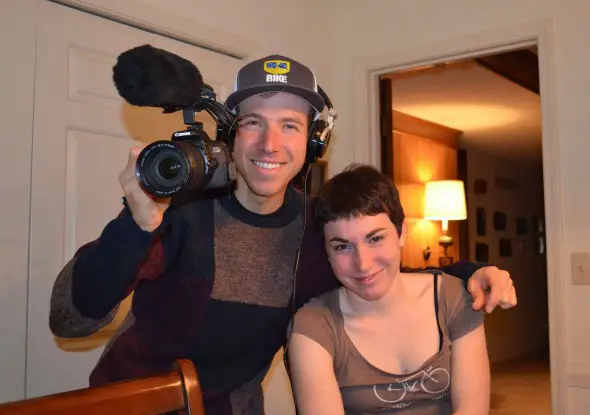
Video series such as Behind the Barriers allowed Jeremy Powers, Ryan Trebon and others to showcase their personalities … behind the barriers. © Jake Sisson
CXM: You’ve kind of transitioned from that video age to the social media age our athletes exist in now. Do you think that’s sustainable, or do we need the bigger media partners?
RT: The problem with social media for individuals is you have to seek out that individual. You’re having to say, oh, I’m going to follow Stephen Hyde. I wonder what Stephen Hyde is up to. Maybe folks don’t know about Kerry Werner, or he’s not as well-known, but if it’s on a different platform where it’s everybody participating in it, you get to know a lot more of these individual personalities and some of them may resonate with you, but you didn’t know about them before. Social media is great for getting your message across to people who want to hear what you have to say, but if you want to get everyone involved and not just rely on folks to seek you out individually, I think you need a medium where everyone is kind of participating in it instead of each person doing their individual thing.
You know, some people just aren’t really good at the social media stuff, but they’re good racers and funny people, they just don’t give too much of a care about putting things out on social media. I think it’s a great platform, I just don’t think it should be the only way you can get your message out. Because then you’re just kind of telling people what you want to. I like traditional media stuff because it’s interactive with someone else. It kind of pushes you to say things you don’t necessarily want to say, instead of you just saying, “Oh, this is fantastic,” and putting your spin on everything. That’s just my personal take. Social media is good, it’s just very self-serving. I think media should be asking questions and getting answers for things athletes don’t necessarily want to talk about.
CXM: I thought you did a great job getting media coverage for the US Cup-CX last year. Were you successful in executing your plan, and if you get to do this again next year, what more will you do?
RT: For what we set out to do for the first year, I think it was extremely successful. It was well received and people were into it. In terms of changing the plan, I don’t think it needs adjustment. Once we started gaining traction with people, it just kind of snowballed. It’s getting people to go, “This is good. This is where we should send our resources.” And having the media and teams get involved. Then everyone is promoting it versus us just pushing the same line all the time. I want people involved and I want people to be excited about it and not have to twist their arms to get them to do things. I think once they see it’s beneficial for them and beneficial for everyone involved, then it’s easy to get behind.
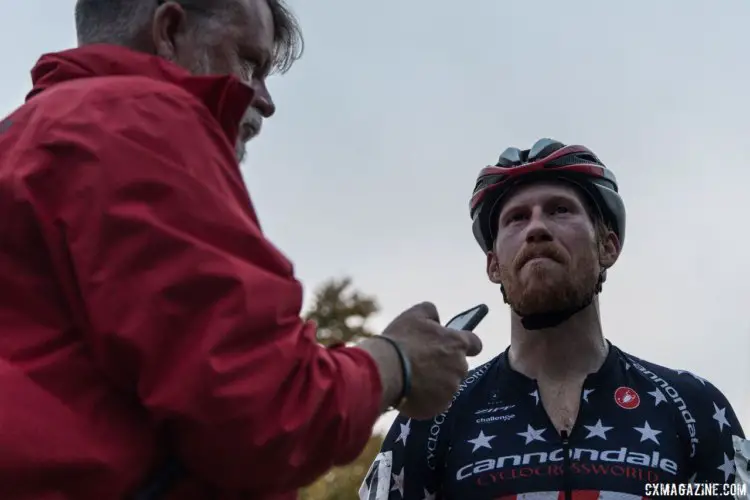
The 2017 US Cup-CX had a good amount of media coverage to tell the story of the great racing. 2017 Derby City Cup. © D. Perker / Cyclocross Magazine
CXM: Changing directions a little bit, you’ve obviously been focusing on the professional side of racing. Have you given any thought to trying to develop the more grassroots side, the participation side in a way of kind of going from the bottom up?
RT: What I want to do next year is to expand the professional calendar and add a weekend, so we’d have five weekends of racing on the schedule. And then I want to do age group category stuff for two of the weekends. Just to give people a reason to travel to the events and go to new places and get the race promoters more reason to be involved at all levels.
CXM: So you’re saying for say, Masters 45+, there would be a mini-series for them?
RT: Yeah. Instead of saying, hey guys I know you work full-time and we’re expecting you to travel five times in a year and then go to Nationals, we’re going to create a smaller series during the US Cup for age group categories. You know, Masters 35 to 65 or something. It would be two or three weekends instead of five. It makes it easier logistically for them to do the whole thing, it gives them something to chase and it helps them prepare for Nationals as well.
CXM: It’s kind of like how they’re doing age group races for Pan-Ams this year.
RT: I remember when the USGP was going on, tons of people I knew would travel around to do age group races. It was cool. It was something they could chase if they’re really into ’cross. They didn’t mind traveling four or five times during the year. I think people would do the same now because they want to go new places and try out different events, but they don’t want to go there just to see another event. They’d like to come if it was part of a series. If it was relatively easy to get to the events and made sense logistically, then that’s a pretty easy buy-in for Masters racers.
CXM: Jingle Cross and the Trek Cup are always really cool because they bring a lot of the top Masters talent from the Midwest and there’s always great racing. I think that idea would be cool to replicate and make part of a series.
RT: Those are the biggest categories we get, and they’re a big driving force behind cyclocross in the U.S. We want them involved and getting excited about it. If they’re traveling to race, it will help people get just as excited about the professional stuff. I think it would be good for the sport to have that stuff again. That was my big push for this year, but you can want to do a lot of things, but if it doesn’t happen then…
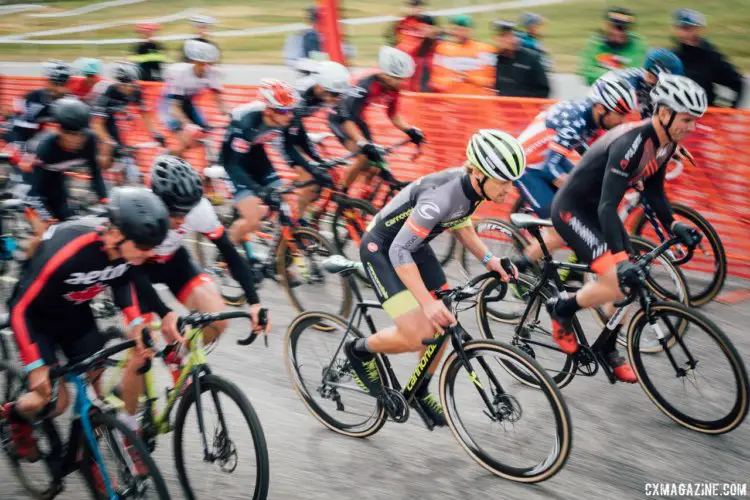
Trebon is hoping to create a national-level Masters series alongside the US Cup-CX. 2017 KMC Cross Fest Day 1 (Friday) © J. Curtes / Cyclocross Magazine
CXM: What do you think USA Cycling should do differently with respect to both pro and grassroots development?
RT: The grassroots stuff is hard because I think we have a pretty robust ’cross scene in the U.S. There’s a ton of racing out there. I think USA Cycling should make it easier to have events. Cheaper to put things on. Number one, the cost needs to go down. It costs to pay officials and testing and all that. It really is expensive. Some of the biggest budget items are officiating and Race Clean and stuff like that. Just kind of get out of the way and let the market do what it wants to do and build great events that way.
On the professional side, I think USAC needs to invest in keeping athletes in cyclocross and mountain biking, or they’re just going to go to the road because that’s one of the only viable sources of making an income right now. The National Team they started was basically because it’s the only way they can get athletes to Europe to do the World Cups for mountain biking. I think spending money on cyclocross to get Juniors and U23s over to Europe to race will be beneficial, but if they don’t have anywhere to go once they’re out of the younger categories, where are they going to race?
I think that’s why having a series in the U.S. is it gives them a place to stay and then hopefully companies will come back in and sponsor teams and stuff like that. If we don’t have anything for a company to sponsor, like a program, where are athletes going to go race? Just a collection of races? Without a dedicated series, people won’t invest in it.
CXM: One thing that’s apparent from talking to most athletes is they want to stay here and race in the U.S. And we saw with the US Cup, where it’s bringing riders together and they’re forming friendships and training together and it seems like that is really good for their development and the sport.
RT: Yeah. I don’t know who’s driving cycling in the U.S.—I don’t know if it’s the UCI or USA Cycling—but whatever they’re doing on the top end is murdering the bottom end. It’s murdering the national level racing. Domestic road racing in the U.S., it sucks. Once the Tour of California came around and everybody was like, “We have the Tour of California, the Tour of Utah, the Tour of Georgia,” these big pro tour events, it just undercut the entire domestic scene. And the domestic road racing is really struggling.
I see a lot of that in cyclocross as well. We have two World Cups in the U.S., but we have nothing else. If all we have is two World Cups and then a really spread out national series here in the U.S., then what do we have? They spend all this money to bring Europeans over, but then we’re not developing anything of our own.
If you look at the way Switzerland is coming back and doing the EKZ Tour, they’re having a really great national series. They have the best mountain bikers in the world, and I think they’re trying to develop some more cyclocross talent as well. You have to own your home and then build bigger things. I think it’s great having the World Cups in the U.S., but man, that’s a ton of money. They’re in September, and then once that’s done, what else are we going to do for cyclocross?
CXM: What else are you up to? Is this your full-time gig right now?
RT: Yeah, essentially.
CXM: We heard you may have signed up for some two-wheel racing?
RT: No, no bike racing. I’m pretty happy with the racing I’ve done in the past, and I don’t really need to do any more.
CXM: Motorcycle then?
RT: I’m thinking of doing some motorcycle races.
CXM: Finally, we recently did a story about U.S. Nationals podiums, and you are kind of the winner of most second places at Nationals. How do you feel about that?
RT: It’s better than third place, right? I would have been nice to have won them, but it is what it is. I lost twice when the races were in my hometown, which was pretty annoying. They were both pretty close, but that just is what it is.
It’s better to be there. For that 10 year stretch, I was always close to first or second. I’d rather do that than get first and then finish 20th the next year. I was consistently at the front for most of my career.
CXM: Cool. Thanks a lot for your time, and good luck to you.
RT: No worries. Thank you.

